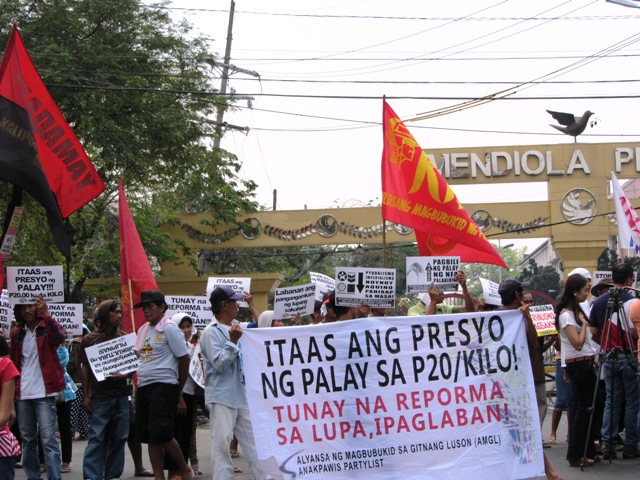By JUSTIN UMALI
Bulatlat.com
MANILA — Marimar (real name withheld upon request) is a farm worker in Pangil, Laguna. During the August-September harvest season, she and her family managed to take home P500 for two days’ work, as part of her share in the palay harvest.
“It’s much smaller compared to before,” she said in Filipino. “Even darak (ground rice bran used as pig feed) sells higher than the actual grain.”
Palay prices are now P8 per kilo. Last year it was P17 to P18 pesos per kilo. (One US dollar is to P52)
Marimar is one of the almost 500,000 farmers affected by the sudden drop in palay prices due to rice tariffication. The economic costs of farming palay, she said, far outweigh the benefits of selling it. She, alongside others from the Southern Tagalog region, decided to camp out in front of the Department of Agrarian Reform office in Manila to protest their current condition and ask for economic protection.
The Katipunan ng mga Samahang Magbubukid sa Timog Katagalugan (Kasama-TK) estimates that there are roughly 2.4 million palay farmers nationwide, with roughly 195,600 farmers in the Southern Tagalog region. Currently, farmgate prices of palay range from P8 or P9/kilo in Siniloan to P11/kilo in Santa Cruz, while rice in the market costs from P27/kilo to P43/kilo, or sometimes as much as over P50.
Conditions have gotten so bad that some farmers have resorted to planting other crops. “I mostly plant corn or eggplant now,” said Raymond (real name withheld upon request), a farmer in Lupang Ramos, Dasmariñas, Cavite. “I still plant palay, but I don’t sell it anymore. It’s just too costly.”
Expenses are higher than income
Marimar, Raymond, and the other farmers of KASAMA-TK are asking the Duterte administration to set palay prices at P20 pesos per kilo. “We really need it to keep our prices competitive,” said Marimar. “Private traders are taking advantage of low prices and making extreme profit on rice.”
According to KASAMA-TK, a palay farmer can, on average, harvest 100 cavans (one cavan is equivalent to 50 kilograms) of palay from a single hectare. Fifteen cavans would go to the land-owner as part of their share. The remaining 85 cavans, which sold at P8 per kilo, amounts to P34,000.
A farmer can, on average, spend P50,200 per hectare, according to a Masipag study. With the current P8-per kilo price of palay, deficit per hectare amounts to P16,200.
Should the demand for 20 pesos per kilo be met, farmers would get P85,000 gross sales. This would translate to an estimated income of P34,800 for every harvest season.
Currently, the Department of Agriculture and the National Food Authority are offering what are at best, band-aid solutions to the farmers’ crisis. The NFA is mandated to buy palay at P19 per kilo, provided that the palay is “dry and clean, with a moisture content below 14 percent”. Palay that does not meet this criteria gets bought at lower prices, ranging from P15 to P17 per kilo.
However, the NFA is only meant to store buffer stock for 15 to 30 days’ worth, and its P8-billion budget is not enough to offset the non-competitive pricing of cartels and private traders. Currently, NFA stock accounts for roughly 11 percent, or 978,000 metric tons (MT) out of the 8.4 million MT of locally produced rice.
The DA is also offering a zero-interest P15,000 loan to roughly 100,000 eligible farmers, payable over eight years. These solutions, Kasama-TK says, do not address the fundamental issues of farmers.
“What farmers need is a subsidy, not a loan,” said Eddie Billones, spokesperson for Kasama-TK. “It’s like the government gave us a lollipop but took it away the moment we tried to have a taste.”
Primary problem is still landlessness
The DA’s current approach is not to increase farm-gate price, but to offer programs such as farm mechanization loans, free seeds, and training. These efforts, while welcome, do not help farm workers like Marimar.
Farm workers comprise an overwhelming majority of Filipinos working in the agricultural sector. Almost 75 percent of all farmers in the Philippines work as farm workers, brought about by a common problem – landlessness.
Unlike farmers, who earn back their expenses by selling their products, farm workers earn wages, or sometimes, a share of the harvest. Farm workers are usually paid one bucket for every cavan of palay they harvest, roughly equal to 12 kilograms.
Palay farm workers in Southern Tagalog earn on average anywhere from P240 to P370 a day, according to Philippine Statistics Authority
The Philippines, being an agrarian country, maintains antiquated relationships between landowners and tenant farmers, and between tenant farmers and farm workers. Farmers and farm workers like Raymond and Marimar are adamant that the solution lies in genuine agrarian reform, not in band-aid solutions like loans.
Unless these fundamental problems in land control get resolved, attempts to end the farmers’ nationwide crisis seem far away.
The post Cost of palay, cheaper than pig feed appeared first on Bulatlat.


